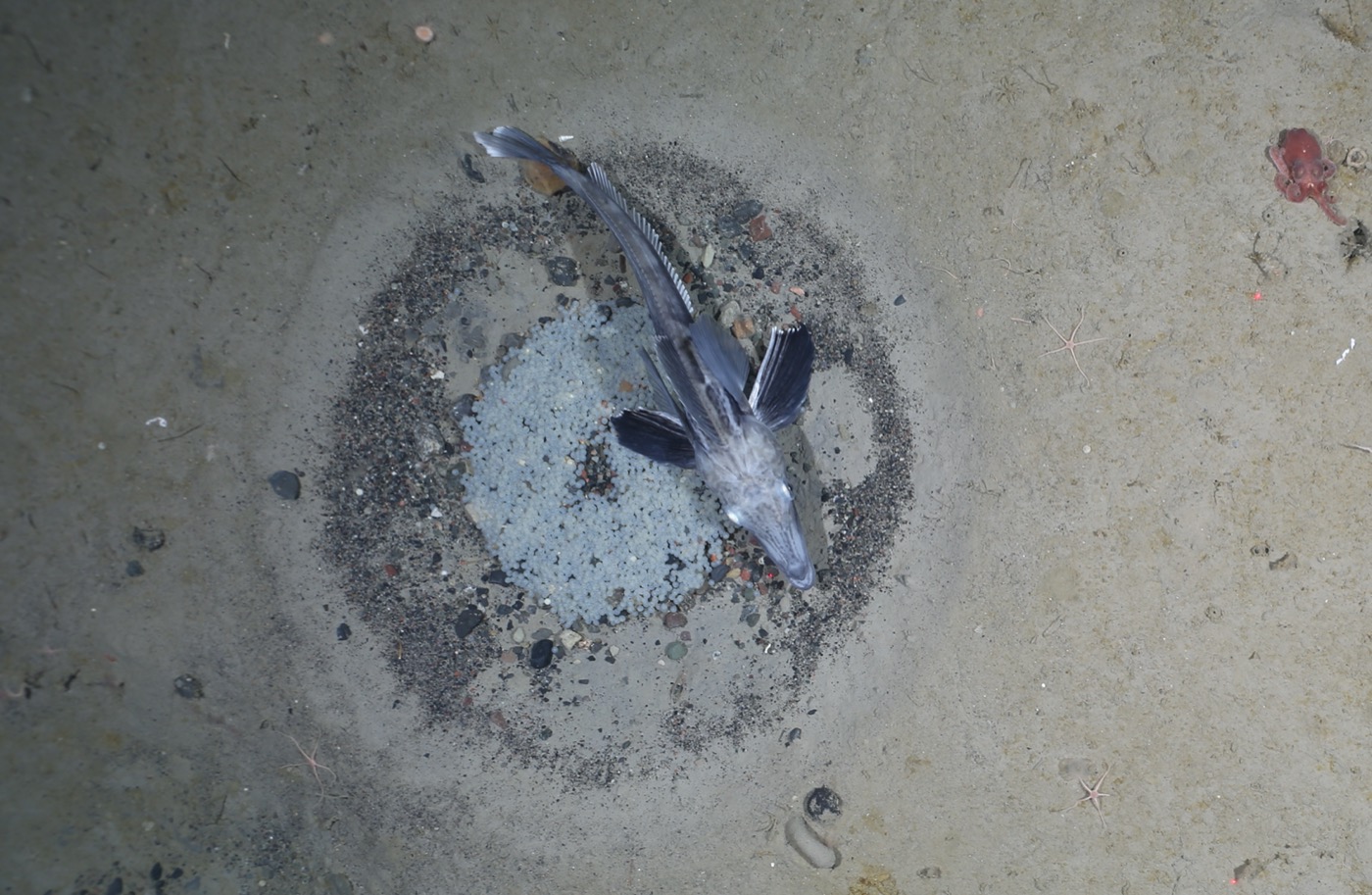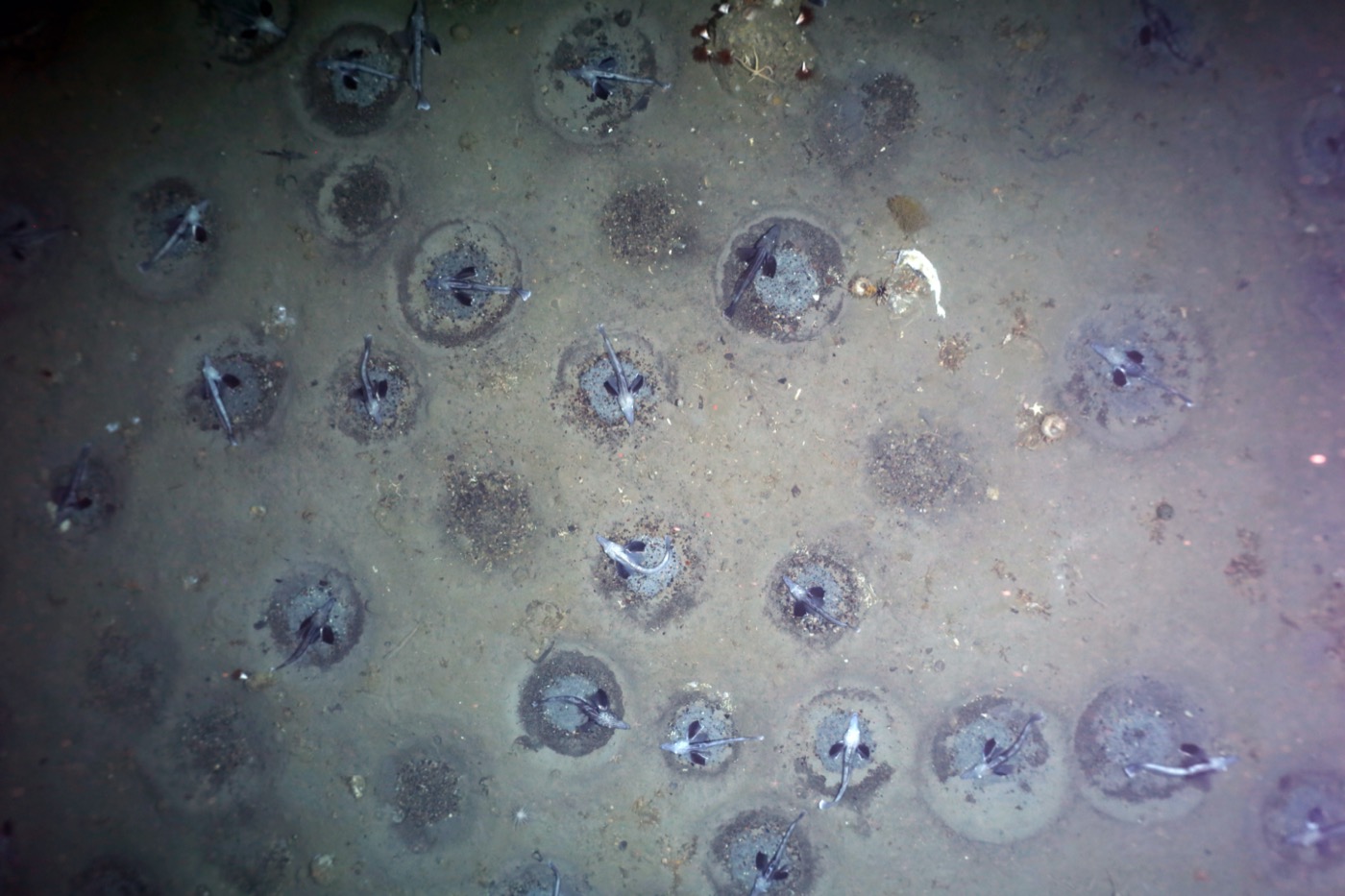A Massive New Find Of Icefish Found Near Antarctic
7:35 minutes

The frigid waters near Antarctica are home to an unusual family of fishes collectively known as the icefish. They have translucent blood, white hearts, and have adapted to live without red blood cells or hemoglobin, relying instead on copper compounds that function better at low temperatures. Now, researchers mapping the floor of the Weddell Sea report in the journal Current Biology that they have spotted a massive colony of the unusual sea creatures—containing over 60 million icefish nests.
“A few dozen nests have been observed elsewhere in the Antarctic, but this find is orders of magnitude larger,” said Autun Purser, of the Alfred Wegener Institute in Bremerhaven, Germany. Purser and his colleagues were mapping the seafloor of the Filchner ice shelf region, in an area of thermal upwelling, where there are slightly warmer temperatures. They found masses of icefish nests clumped close together as far as the eye can see, somewhat like a land-based colony of nesting penguins.
Purser joins Ira to talk about the discovery, and what’s known about the ultra-cold ecosystems of Antarctic seas.

Invest in quality science journalism by making a donation to Science Friday.
Autun Purser is a researcher at the Alfred Wegener Institute in Bremerhaven, Germany
IRA FLATOW: For the rest of the hour, a trip to the seas around Antarctica and the ice fish. So you say, what are ice fish? Sounds obvious, right? Fish that live in the cold waters of Antarctica.
But what is not so obvious is that their blood, instead of red, is clear. There’s no hemoglobin. And again, not so obvious is that researchers surveying the Weddell Sea counted around 60 million– 60 million– nesting sites. Joining me now is Autun Purser. He’s a postdoc deep sea biologist and ecologist working for the Alfred Wegener Helmholtz Center for Marine and Polar Research in Germany. Welcome to Science Friday.
AUTUN PURSER: Thank you. Thank you for having me on the show, and thank you for your interest in these bizarre deep sea fish.
IRA FLATOW: Tell us how bizarre they are.
AUTUN PURSER: Well, like you say, they are an unusual fish in as much as they do not use hemoglobin in their blood. They use a copper-based blood instead. And that’s because at 0 degrees, which is the temperature these fish live, this is better for transporting oxygen. On top of that, they’ve taken to living under the permanent ice of the Weddell Sea.
Now, this area is constantly ice covered. It’s sea ice, so it’s about a meter thick. And that means that it’s still possible for photosynthesis to occur underneath this ice. But it’s still a constantly ice-covered environment, which is quite an unusual place to see so many fish across the sea floor.
IRA FLATOW: Why are there so many fish? Were you surprised to see so many?
AUTUN PURSER: Extremely surprised. We knew that these fish lived in the area, and we knew that they nested occasionally in groups of four, five, or six. But we did not expect to see nest after nest after nest.
IRA FLATOW: And tell me how you found them.
AUTUN PURSER: Right, so on our ship, the RV Polarstern, there’s 50 scientists on this expedition. And this expedition was focused on investigating how carbon transports from the surface waters to the seafloor and interacts with the various ecosystems in the water column. And my job was to photograph the seafloor and the benthic community that benefits from this carbon in the end when it reaches the seafloor.
One of the tasks we had on the cruise was to rotate these mooring lines, which are fixed with sensors that measure how flow changes over time when there’s no one in the area. So we have to change the batteries on these devices every couple of years and download the data. So we changed some of these batteries. We’d got the old ropes onto the deck, and we were just reconfiguring the equipment. And I had the chance to put my camera in at the night time while they readied these devices to put back in.
So I didn’t really have much choice of where to dive, so we put the camera in an area which you might consider quite boring by looking at the seafloor topography. It was on the sort of edge of a trough feature on the seafloor. But it wasn’t near where the trough intersects with the continental shelf or anywhere where you might expect some meeting of ecosystems and perhaps a concentration of fish.
So we put the camera down, and from the first glimpses of the seafloor, we saw these nesting fish. And we thought, wow, that’s pretty lucky. We saw a colony of nesting fish. And then they carried on for hour after hour for the entire four hours of the dive–
IRA FLATOW: Wow.
AUTUN PURSER: –where we managed to film about 6 kilometers of seafloor, and there was nothing but fish.
IRA FLATOW: Wow. This is Science Friday from WNYC Studios. When I think of nests, I’m thinking of bird nests. But that’s not what you saw, I imagine.
AUTUN PURSER: No, but it’s somehow a little bit similar to the birds’ nests, or the penguins from the local area. Where penguins gather together in these colonies, there’s not a few penguins straggling around at the edges. The penguins are in one big, dense clump. There’s either no penguins, or all the penguins.
And it was the same with these fish nests. When you’ve reached the colony from filming the seafloor around the area, there’s no nests, there’s no indications of any nests, and then there’s solid seafloor coverage of nests at about one nest per 4 square meters. At that density across what we estimate to be 240 square kilometers of seafloor.
IRA FLATOW: Now, do you have any idea of why they would bunch up like this?
AUTUN PURSER: Yes. So there’s several reasons why I think they’re bunching up like this. The bunch happened to correspond spatially with a tongue of warm water that’s pushed up from the deeper area in the Weddell Sea. Now, the way that the circulation patterns work in this area is that cold water is subducting down into the bottom of the ocean and pushing this warm water up, and it’s the start of the global circulation pattern in the oceans.
We found that this tongue of warm water matched exactly where the fish nests were. So you were in the 0 degrees Antarctic water, and then at 2 degrees, as soon as you went into this tongue of water, the fish nests started. And it was like a knife in the sand. It was exactly the same location.
IRA FLATOW: That is cool.
AUTUN PURSER: Yeah, it’s amazing. And I do not think, however, that this 2 degrees warmer means it’s so much more attractive for the fish. I think that these fish are navigating to this location to find each other. I think there’s such a huge amount of fish here, they’re coming from other areas of the Weddell Sea and potentially the larger Antarctic, and they’re meeting up here, reproducing here, laying their eggs here.
And there’s another supporting piece of information for that. I said we were interdisciplinary crews, and we had experts on the water column, too. And they found, in the surface waters above this colony area, small zooplankton, small animals that are living on the photosynthetic algae just underneath the ice.
And we know from some work our American colleagues did, actually, that these fish like to come to the surface after they hatch. And the juveniles are often found at the ice-water interface. So we hypothesize that these fish are meeting here, reproducing, and when they hatch, the young are going back up to the ice interface and they’re living off the zooplankton that lives off the algae that manages to photosynthesize through this ice.
IRA FLATOW: Amazing. So if they’re living off the algae, what’s living off them? What are eating those fish?
AUTUN PURSER: Yeah, so basically, these tiny little zooplankton, these tiny little swimming animals, are living off the algae. And then these fish are living off that. But then, of course, these fish as they get bigger become attractive prey in themselves. And we now believe that the Weddell seal, this handsome seal that lives in the area, is actually eating these fish.
Now, the reason we think this is because ourselves in Germany and our colleagues in America, South Africa, and England have been tagging Weddell seals for the last decade. And what these tags do is they tell you where the seals are diving and how long they’re spending at different depths. And every time a seal comes back up onto the ice after it’s been diving, it sends that information to a satellite. And what we managed to determine is that the great majority of Weddell seals are actually operating in this area where the fishes are nesting and have been doing for much of the last decade. So that’s really interesting.
IRA FLATOW: Wow. That’s tremendous. You know, it just reminds me how little we know, right, about what’s going on in the deep seas.
AUTUN PURSER: Absolutely. I think that’s really true. I think that we’ve probably filmed only 1% of the Weddell Sea seafloor in anything like this detail, and even less in some other areas of the world ocean. We’re also entering a new period of ocean exploration where robotic submarines can go off and film areas and where, like in this case, towed vehicles can take high-resolution imagery from above while moving quite quickly. So we really can explore more than we have been able to until maybe 20 years ago. So I think we are making discoveries. And I would be very surprised if there’s not sizable finds like this elsewhere in the world ocean just waiting to be discovered.
IRA FLATOW: Well, Dr. Purser, we wish you great luck. This has been fascinating, as someone who’s visited Antarctica many years ago and watched Weddell seals. Just amazing. Thank you for taking time to be with us today.
AUTUN PURSER: Thank you for having me on the show. It’s been brilliant. Thanks.
IRA FLATOW: Dr. Autun Purser. He’s a post-doc deep sea biologist and ecologist working for the Wegener Helmholtz Center in Marine and Polar Research in Germany.
Copyright © 2022 Science Friday Initiative. All rights reserved. Science Friday transcripts are produced on a tight deadline by 3Play Media. Fidelity to the original aired/published audio or video file might vary, and text might be updated or amended in the future. For the authoritative record of Science Friday’s programming, please visit the original aired/published recording. For terms of use and more information, visit our policies pages at http://www.sciencefriday.com/about/policies/
As Science Friday’s director and senior producer, Charles Bergquist channels the chaos of a live production studio into something sounding like a radio program. Favorite topics include planetary sciences, chemistry, materials, and shiny things with blinking lights.
Ira Flatow is the founder and host of Science Friday. His green thumb has revived many an office plant at death’s door.